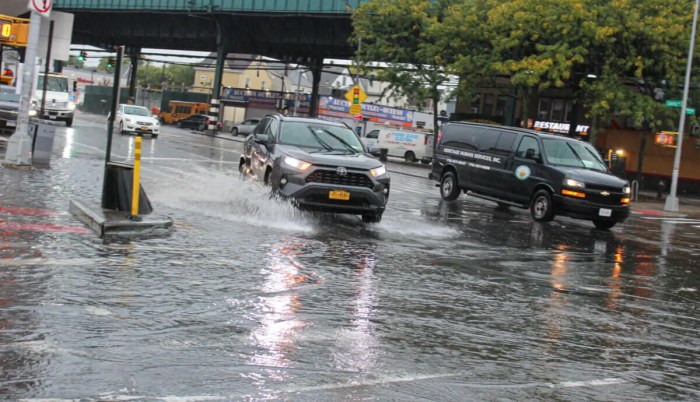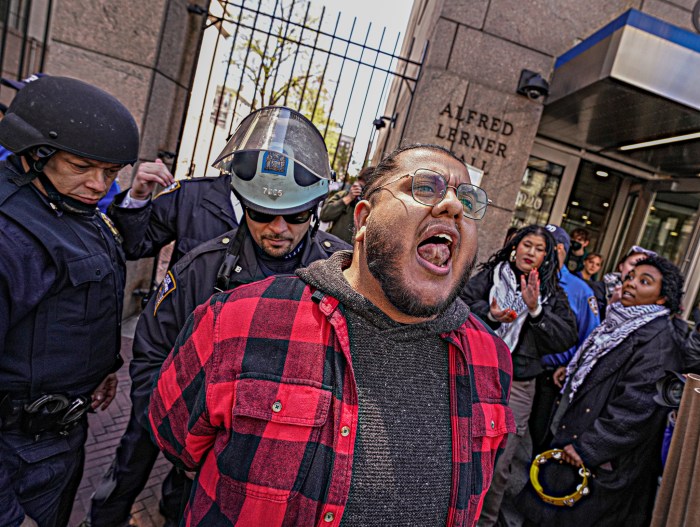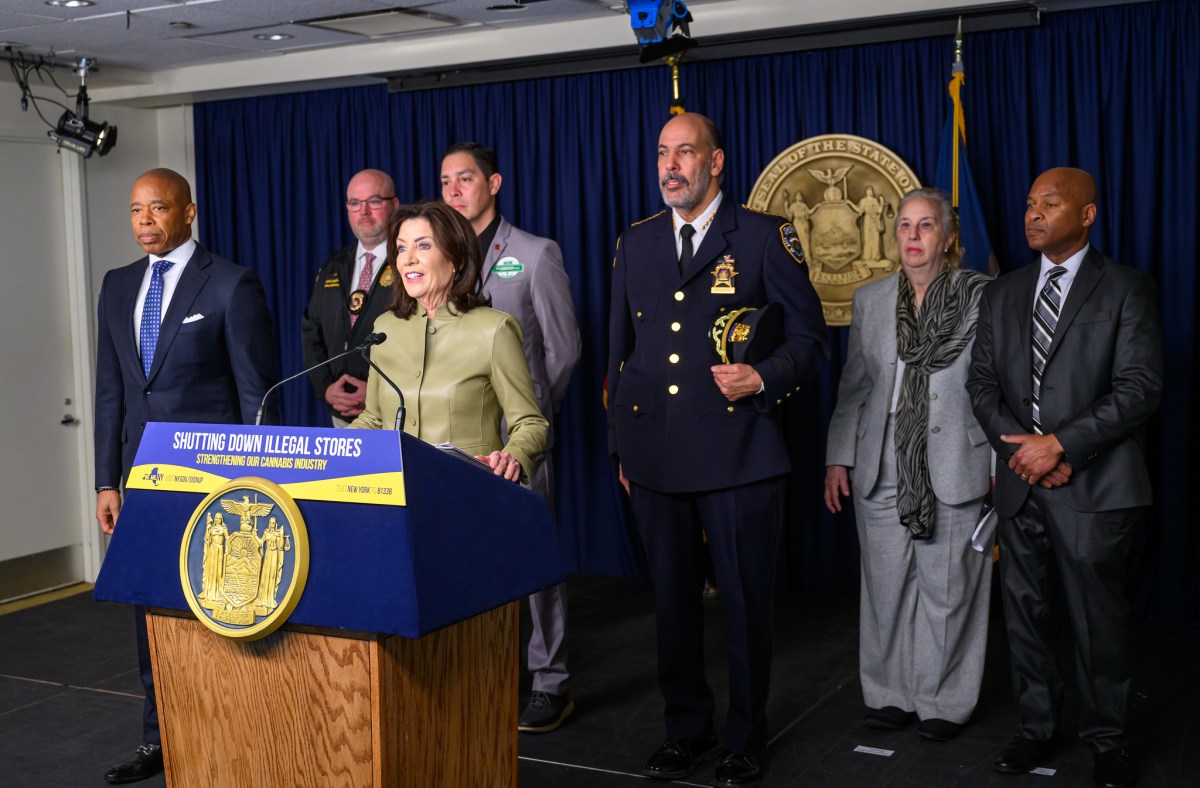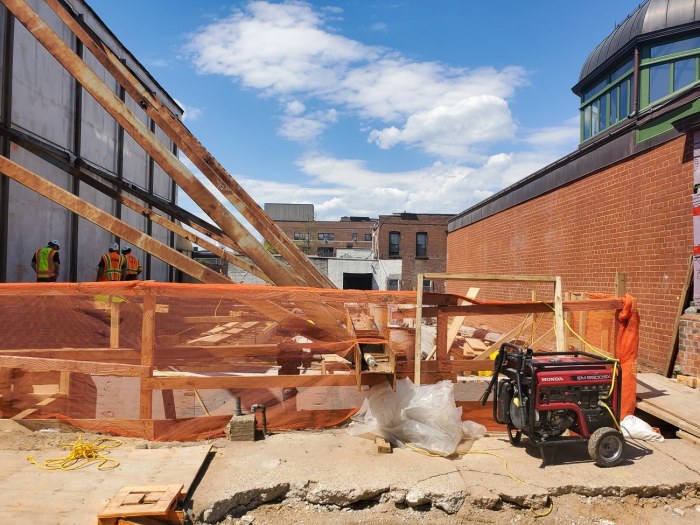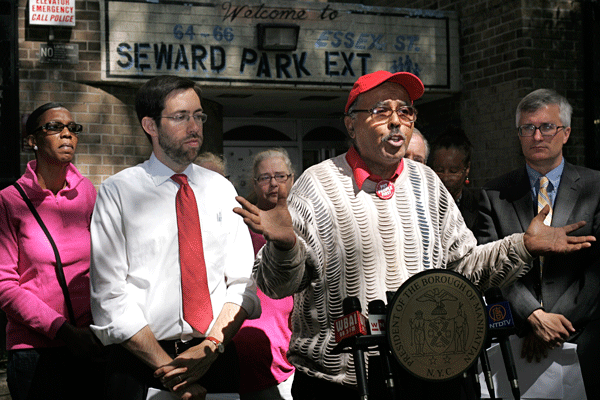
BY SAM SPOKONY | Nearly two-thirds of public housing tenants on the Lower East Side do not feel safe in their homes, according to a report released by elected officials on Friday.
The report, compiled by Borough President Scott Stringer, state Senator Daniel Squadron and Assemblymember Brian Kavanagh, also found that nearly half of New York City Housing Authority buildings in the area lack functioning intercom systems and front doors that lock securely.
“This is a cry for help, and it shows that the most basic security measures, which other tenants across the city take for granted, just aren’t happening in NYCHA,” Stringer said. “It’s time to fix the damn doors and intercoms. You don’t need a bureaucracy to understand that.”
The data was based on an August survey of 520 residents living in Lower East Side and East Village NYCHA developments. Of the 10 buildings surveyed, six lacked security cameras. The report calls for the agency to install cameras in 80 buildings citywide by the end of 2013.
Tenant leaders from some of those developments voiced their concerns alongside the politicians at Friday’s press conference outside the Seward Park Extension on Essex St.
“It’s unacceptable for us to have people who are afraid to come out of their homes,” said Dereese Huff, the tenant association president at Campos Plaza on E. 13th St. “A 5-year-old kid could open the locks on our lobby doors.”
Huff added that because of her building’s lack of safety, she carries a hammer for self-defense whenever she walks the hallways or takes the elevator.
NYCHA’s security standards recently came under fire when Police Officer Brian Groves was shot in the chest in July while on patrol at the Seward Park Extension, which does not currently have security cameras. While his bulletproof vest saved Groves’s life, the gunman has not yet been apprehended.
According to the report, 80 percent of public housing tenants whose buildings are without security cameras said they would feel safer if cameras were installed.
NYCHA immediately responded to the report in a statement, saying that it has had a strategy in place since the beginning of the year that will include improved key technology — using wireless key cards that can’t be duplicated — and modern intercom systems.
The agency also stated that 85 developments, 12 of which are on the Lower East Side, will receive cameras and “enhanced security features” by the end of next year. NYCHA then tried to blame Stringer, Squadron and Kavanagh for the lack of cameras up to this point.
“NYCHA can only install these security measures in developments where elected officials have allocated discretionary funding,” the statement read. “Neither Assemblyman Kavanagh nor state Senator Squadron has allocated funding for this. Borough President Stringer has allocated only marginal funding for the Baruch Houses.”
Stringer shot back by slamming the agency for trying to change the subject.
“NYCHA needs to stop blaming others for its failures,” he said. “There should be nothing ‘discretionary’ about providing front doors and intercoms that work.”
Amy Spitalnick, a spokesperson for Squadron, stressed that the politicians’ report refers to the $42 million of taxpayer money — specifically earmarked for security upgrades — that the agency has been sitting on for years.
She added that Squadron has in fact supported an allocation of $750,000 for security camera installation, but that the state Senate’s Republican majority has blocked the funding for the past two years.
Some tenant leaders also believe that NYCHA’s slowness in providing security-related repairs and upgrades may be due to negative perceptions of people who live in public housing.
Luther Stubblefield, the tenant association president for the Baruch Houses, which run from Delancey St. to Houston St. along the F.D.R. Drive, said the tenants have diverse needs.
“There are stereotypes about public housing tenants that say that we’re all criminals, and that we must be the cause of our own problems,” he said. “But we have retired families, we have senior citizens, we have disabled people.”
Another tenant, who came from his home on Henry St. to hear Friday’s press conference, was convinced that, despite the outcry, changes would never actually take place due to the reasons Stubblefield highlighted.
“It’s considered shameful for people to live in these developments,” said the man, Robert, who declined to give his last name. “Society sees us only as poor and lazy, and not as real human beings. But these security measures really are a matter of life and death.”
The vast majority of public housing tenants are not white.
In their report, Stringer, Squadron and Kavanagh also decried the fact that NYCHA is forced to pay the Police Department more than $70 million each year in order to maintain police services on its property. The officials called for renegotiating a 1994 memorandum of understanding, between NYCHA and the Police Department, which has since resulted in roughly $1.2 billion of public housing money being diverted into the city’s coffers, according to the report.
“NYCHA is the only landlord in the city that’s required to pay for policing,” Squadron said. “So if you’re a public housing resident, your tax dollars literally aren’t good enough to get you those services.”
Nearly half of those surveyed in the report thought that the police presence in their buildings were inadequate, and more than 40 percent reported that they rarely or never see police officers during a typical week.
NYCHA is the city’s largest landlord, housing more than 400,000 residents. More than 30,000 of those people —about 8 percent — live in developments on the Lower East Side.











